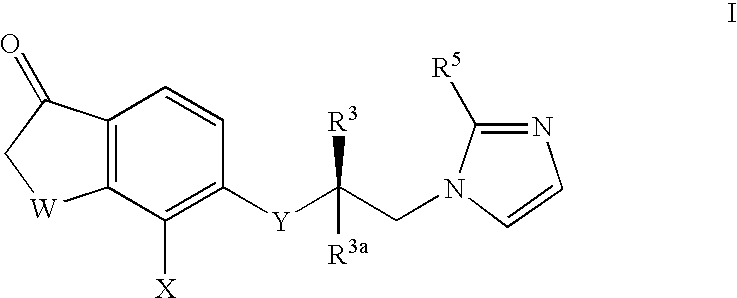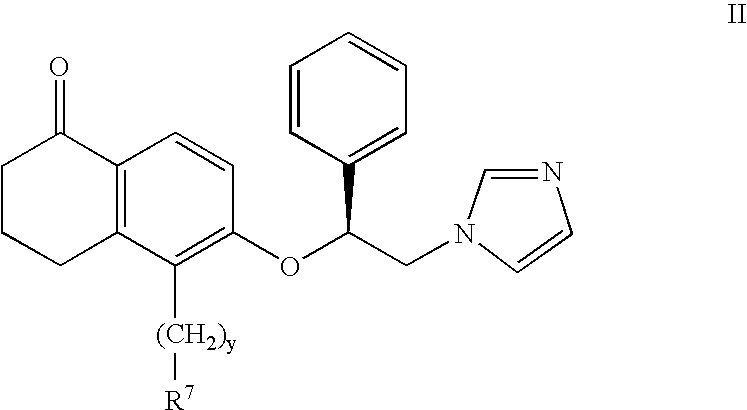5-substituted tetralones as inhibitors of ras farnesyl transferase
a technology of ras farnesyl transferase and substituted tetralones, which is applied in the field of compounds, can solve the problems of uncontrolled cellular proliferation, uncontrolled feedback regulation of proteins, and various surgical revascularization techniques, and achieves the effects of preventing uncontrolled or abnormal tissue proliferation, and reducing the risk of revascularization
- Summary
- Abstract
- Description
- Claims
- Application Information
AI Technical Summary
Benefits of technology
Problems solved by technology
Method used
Image
Examples
example 1
Synthesis of 6-((1S)-2-Imidazolyl-1-phenylethoxy)-5-(phenylthiomethyl)-2,3,4-trihydronaphthalen-1-one (Compound 1)
[0485]1. 6-Hydroxy-5-phenylthiomethyl-2,3,4-trihydronaphthalen-1-one
[0486]To a solution of thiophenol (9.42 g, 0.0855 mol) in oxygen-free tetrahydrofuran (100 mL) is added diisopropylamine (3.68 g, 0.0285 mol). 5-Chloromethyl-6-hydroxy-2,3,4-trihydronaphthalen-1-one, prepared as described in Chem. Pharm. Bull. 1977;25(11):2988-3002 (6.0 g, 0.0285 mol) is dissolved in tetrahydrofuran (200 mL) and the solution added dropwise to the preceding solution at 25° C. The mixture is stirred for 2 hours, concentrated in vacuo and the residue layered with ethyl ether. The suspension is extracted with 1N NaOH, which is separated and washed with ethyl ether. Upon standing a solid precipitate forms within the aqueous phase. The solid is filtered, dissolved in ethyl acetate, and the solution is washed with 1N citric acid, brine and dried over anhydrous magnesium sulfate. The suspension...
example 2
Synthesis of 6-((1S)-2-Imidazolyl-1-phenylethoxy)-5-[(phenylsulfinyl)methyl]-2,3,4-trihydronaphthalen-1-one (Compound 2)
[0489]To an ice cold solution of compound 1 (0.60 g, 1.32 mmol) in 10 mL tetrahydrofuran is added a solution of NaIO4 (3.3 mL 0.5M in H2O). The mixture is stirred 3 days at 25° C. Another portion of NaIO4 solution (6.6 mL 0.5M in H2O) is added and after stirring for 6 hours at 25° C., the mixture is filtered and the filtrate is extracted with chloroform. The organic phase is washed with brine, dried over anhydrous magnesium sulfate, and filtered. The filtrate is evaporated to a solid (550 mg). The mixture is purified by reverse phase silica gel chromatography giving the product (Compound 2) as a trifluoroacetate salt (100 mg, 16% yield). MS: APCI: M+1: 471.1 (M: 470.6). NMR spectrum is consistent with structure. Calcd. for C28H26N2O3S.0.10H2O.1.45 TFA:
[0490]
Theory:C 58.20,H 4.34,N 4.39,H2O 0.28F 12.96.Found:C 58.51,H 4.61,N 4.23,H2O F 13.00.
example 3
Synthesis of 6-((1S)-2-Imidazolyl-1-phenylethoxy)-5-[(phenylsulfinyl)methyl]-2,3,4-trihydronaphthalen-1-one (Compound 3)
[0491]1. 5-Benzenesulfonylmethyl-6-hydroxy-2,3,4-dihydronaphthalen-1-one
[0492]To a suspension of 6-hydroxy-5-phenylsulfanylmethyl-2,3,4-trihydronaphthalen-1-one (7.0 g, 0.025 mol) in 300 mL dichloromethane is added a solution of 73% meta-chloroperbenzoic acid (11.82 g, 0.05 mol) in 150 mL dichloromethane. The suspended solids dissolve, followed by precipitation of another white solid. After stirring 3 hours at 25° C., an additional portion of 73% meta-chloroperbenzoic acid (2.95 g, 0.0125 mol) in 11 mL dichloromethane is added. The mixture is then stirred for 1 hour and extracted with saturated potassium carbonate solution (475 mL). The organic phase is washed with brine, dried over anhydrous magnesium sulfate, filtered, and evaporated to a solid. The pH of the carbonate is adjusted to 8 with concentrated HCl and washed with ethyl acetate. The ethyl acetate is was...
PUM
| Property | Measurement | Unit |
|---|---|---|
| body weight | aaaaa | aaaaa |
| pH | aaaaa | aaaaa |
| volume | aaaaa | aaaaa |
Abstract
Description
Claims
Application Information
 Login to View More
Login to View More - R&D
- Intellectual Property
- Life Sciences
- Materials
- Tech Scout
- Unparalleled Data Quality
- Higher Quality Content
- 60% Fewer Hallucinations
Browse by: Latest US Patents, China's latest patents, Technical Efficacy Thesaurus, Application Domain, Technology Topic, Popular Technical Reports.
© 2025 PatSnap. All rights reserved.Legal|Privacy policy|Modern Slavery Act Transparency Statement|Sitemap|About US| Contact US: help@patsnap.com



